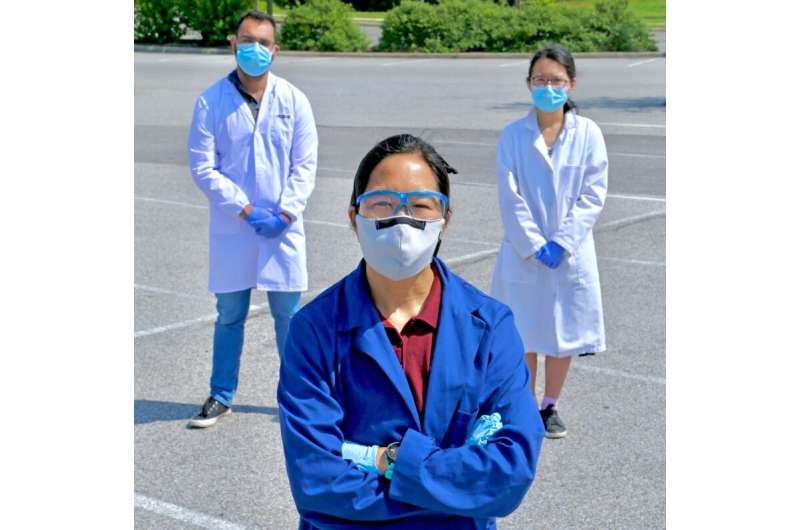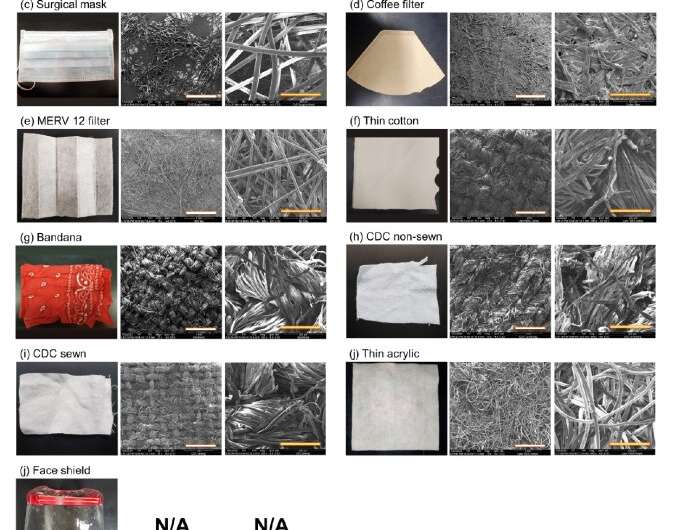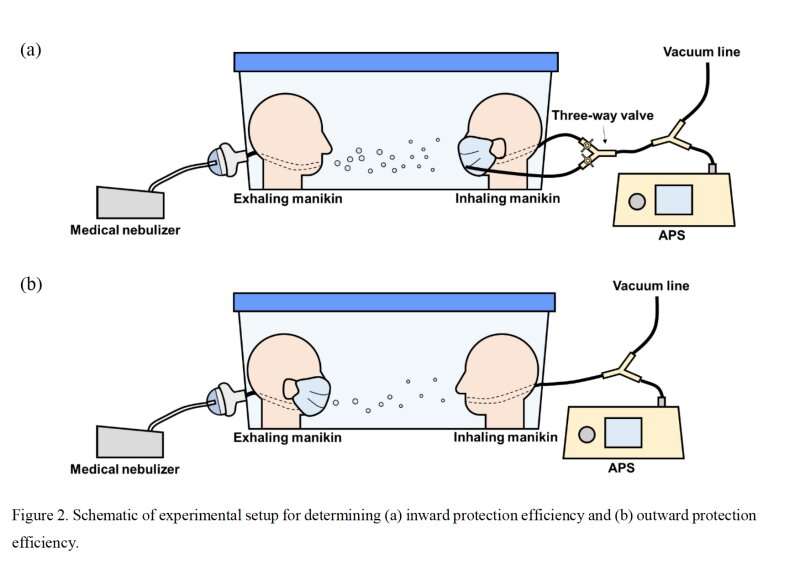Linsey Marr, the Charles P. Lunsford Professor of Civil and Environmental Engineering at Virginia Tech, and an expert in airborne disease transmission, stands with Charbel Harb (left) and Jin Pan (right), both Ph.D. students. Credit: Alex Crookshanks | Virginia Tech
A newly released Virginia Tech study examining the efficacy of common face coverings may help a concerned public breathe a sigh of relief.
The research, led by airborne disease transmission expert Linsey Marr, found, based on testing different materials, that a three-layer mask consisting of outer layers of a flexible, tightly woven fabric and an inner layer made from one of several materials designed to filter small particles, should provide at least 74 percent material filtration efficiency for the most penetrating particle size.
At a particle size of one micron—the average size of respiratory droplets produced during breathing and speaking—Marr and her research team found filter materials can easily have a filtration efficiency of 75 percent, with common fabrics registering at about 40 percent. When combined together in a face covering, the group calculated that materials should have an overall efficiency greater than 90 percent in some cases.
"Some people say, 'Well, an N95 respirator can block 95 percent of that most penetrating particle size, and anything else is worthless,'" said Marr, the Charles P. Lunsford Professor of Civil and Environmental Engineering in Virginia Tech's College of Engineering. "It's true that some of the cloth masks that we looked at only block 10 or 20 percent at that size. But once you get up to the sizes that we think are more important for transmission, like one to two microns and even five microns, those cloth masks are able to block half or more."
The SARS-CoV-2 virus itself is about 0.1 microns in size, but "it doesn't come out of us naked," Marr said, speaking about the virus that causes the disease known as COVID-19. It's carried in larger respiratory droplets, also known as aerosols, that contain salts, proteins, and organic compounds, leading to aerosols up to 100,000 times larger in mass than the virus itself.
Marr said previous research has shown that most such aerosols are larger than half a micron, leading the study team to focus on a size range of one to two microns as most relevant for testing homemade and commercially available face coverings.
"It's not something I would ask a health care worker to wear in high-risk situations," she said. "They need the best protection we can get. But given that it's impractical to have everyone in the general public walking around wearing an N95, I think homemade masks are definitely helpful."
The group's experimental setup was designed to represent conditions closer to that of a mask wearer's real-world experience, albeit in the controlled environment of a laboratory study. Typical testing of this nature is based on standards developed for N95 respirators by the National Institute for Occupational Safety and Health, which don't align with how much of the public wears and uses common face coverings in response to the pandemic.
Marr is one of a handful of researchers in the world with unique expertise in how airborne pathogens interact with and travel in the air. With a field of experience that suddenly became vitally important this year and an uncommon strength at communicating complex science to the lay public, Marr has emerged as a go-to source for public health agencies, journalists, and the 29,000 people who follow her updates on Twitter.
Her team's study, published Nov. 20 on the preprint server medRxiv, has not yet been peer reviewed. Marr and her team are awaiting publication in an academic journal.
Scanning electron microscope images of the materials tested. Credit: Virginia Tech
But Marr's approach was "exhaustive," said William Ristenpart, who studies airborne disease transmission at the University of California-Davis and was not involved in the study. Ristenpart has conducted his own mask efficacy studies and said the Virginia Tech team's study design, methods, and technique help elevate the findings.
An N95 respirator, still considered the gold standard by scientists and health care agencies for protection against the SARS-CoV-2 virus, gets its name from the test it has to pass: the respirator must trap 95 percent of particles 0.3 microns in size.
That 0.3 mark makes for the "most penetrating particle"—the hardest to filter, that is. Previous mask efficacy studies have focused on medical-grade masks and that smaller, trickier, submicron size range. Less is known about the cloth face coverings now increasingly available from many companies—as well as those based on designs released by the Centers for Disease Control and Prevention which people can craft at home—and how well they trap particles closer to the sizes humans emit while breathing, talking, or coughing.
In the study, Marr and her team of civil and environmental engineering researchers shifted focus to the masks and particle sizes they analyzed and found to be most important to investigate in the context of how people go about a typical day wearing face coverings. They evaluated nine homemade masks and their constituent material, as well as a surgical mask and a face shield, for their ability to trap particles ranging in size from 0.04 microns to more than 100 microns.
Each mask underwent tests for outward efficiency—the ability to trap particles exhaled by the mask wearer—and for inward efficiency for mask wearers as they inhale. The researchers tested masks and filtration materials made of one and two-ply bandanas; thin cotton; thin acrylic; microfiber; a vacuum bag; a coffee filter; a MERV 12 filter; two layers of cotton from a pillowcase to reproduce a mask sewn using instructions from the CDC; and cotton from a T-shirt to reproduce a non-sewn design also offered by the CDC on their website.
At the low end of particle sizes, from 0.1 to 0.3 microns, the homemade masks performed poorly. But when the masks were challenged with one and two-micron particles or larger, their effectiveness shot up. Several could trap 50 to 80 percent of particles in tests of both inward and outward efficiency.
That's significant, Marr said, given what scientists have learned in the last 12 months about how the SARS-CoV-2 virus is expelled and carried aloft in air, and the average size of such droplets.
The team used three metrics to test homemade mask effectiveness in the lab: material filtration efficiency, inward protection efficiency, and outward protection efficiency. They tested for material filtration efficiency first, to see how the various fabric and filter materials would perform before being made into masks. In these experiments, the researchers sprayed sodium chloride particles from a liquid salt solution into a large bag and measured the number and sizes of the particles in the bag. They used a vacuum pump to pull air containing the particles through the material and measured the number and size of particles that made it through to the other side.
To test inward and outward protection efficiency, Marr's team mounted two manikins on opposite sides of a 570-liter chamber, mimicking a pair of inhaling and exhaling people talking closely. The researchers connected the exhaling manikin to a medical nebulizer that generated droplets from the manikin's mouth. On the opposite end, they fed a vacuum line through the mouth of the inhaling manikin to pull in air containing emitted particles. Measurements were then taken of particles in the chamber as they were emitted from the exhaling manikin, or those pulled through the inhaling manikin.
The researchers ranked the homemade masks and filtration materials based on the three study metrics. The vacuum bag performed best, with a material filtration efficiency of at least 60 percent under controlled conditions, climbing to 80 percent at two microns. Its outward protection efficiency and inward protection efficiency measured at greater than 50 percent and 75 percent respectively for particles 0.5 microns or larger.
The laboratory setup. Credit: Virginia Tech
Mid to high-level performers included the MERV 12 filter, surgical mask, and CDC sewn mask, with all three up providing 50 percent or higher inward and outward efficiency for particles at the two-micron mark. Thin acrylic performed the worst or near-worst among homemade masks for all three metrics.
Comparing inward and outward protection efficiency, the team found that masks tended to perform better as sources of outward protection than inward, but the differences in most cases were not statistically significant. The two efficiencies diverged for stiffer materials and those worn more loosely—like the bandana—or more tightly compared to a standard earloop mask.
Marr and her team found several of the results for each metric surprising. The two-ply bandana and the non-sewn CDC mask made of T-shirt cotton performed better than Marr expected at particle sizes of one to two microns. The thin cotton—a soft, tightly-woven fabric like that of a blouse—also stood out, with inward and outward protection efficiency at those sizes just shy of or at 50 percent.
The researchers used modified droplet deposition analysis to test the efficacy of the largest particle sizes they examined, at 20 microns or more. The approach is similar to the method employed for outward protection efficiency, but used an airbrush instead of a medical nebulizer to emit the largest particles. The brush was filled with a salt solution containing red food dye. The analysis showed no stains in the slides for any of the face coverings tested, indicating that all were able to trap particles larger than 20 microns in size.
Combining the study's findings with existing published literature on mask layering, Marr's team came up with recommendations for fashioning a particularly effective homemade face covering: make it three layers, with a soft, flexible, tightly woven fabric layer up against the mouth; a layer made of material designed to filter particles, like a vacuum bag or MERV 14 filter; and finally, another soft and tightly woven outer layer of fabric. The face covering should fit snugly against the wearer's face with no gaps that could affect its performance.
Jin Pan, a civil and environmental engineering Ph.D. student who co-authored the study, said she was motivated to run the experiments to surface helpful knowledge during the pandemic, and by her own curiosity as a scientist.
"I saw many people's sacrifice in this pandemic, including patients and healthcare workers," Pan said. "I really wanted to do something. I felt like this is something I could do. We have the equipment, we have the expertise, and I was curious. What material could provide the best protection?"
Charbel Harb, another Ph.D. student, and Weinan Leng, a research scientist, also contributed to the study.
Because the team's experimental setup tested masks in tightly controlled conditions, the research has certain limitations, Marr said. Without human subjects, the experiments don't factor in variables like mask adjusting or variability in air flow that occurs with human inhalation and exhalation. Additionally, the air flow used in the study design generated particles at a continuous rate, and was limited to one direction at a time.
Still, Marr said she believes that laboratory studies can work together and alongside other research, like observational epidemiological studies, to give a fuller picture of mask efficacy in reducing transmission.
"No one study by itself is going to tell you the whole story," Marr said. "And no one intervention—masking, social distancing, handwashing, indoor ventilation—will stop the spread of COVID-19 alone. The mask is one of the many interventions that we need to combine together."
More information: Jin Pan et al. Inward and outward effectiveness of cloth masks, a surgical mask, and a face shield, (2020). DOI: 10.1101/2020.11.18.20233353
Provided by Virginia Tech


























